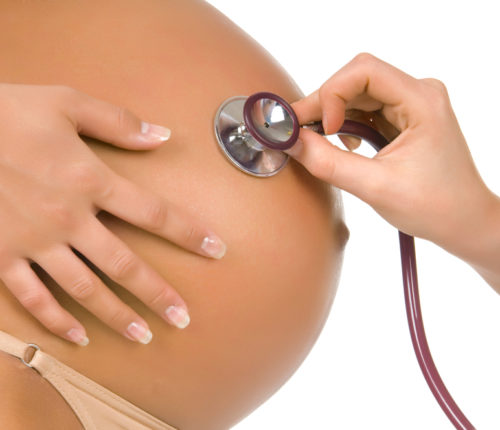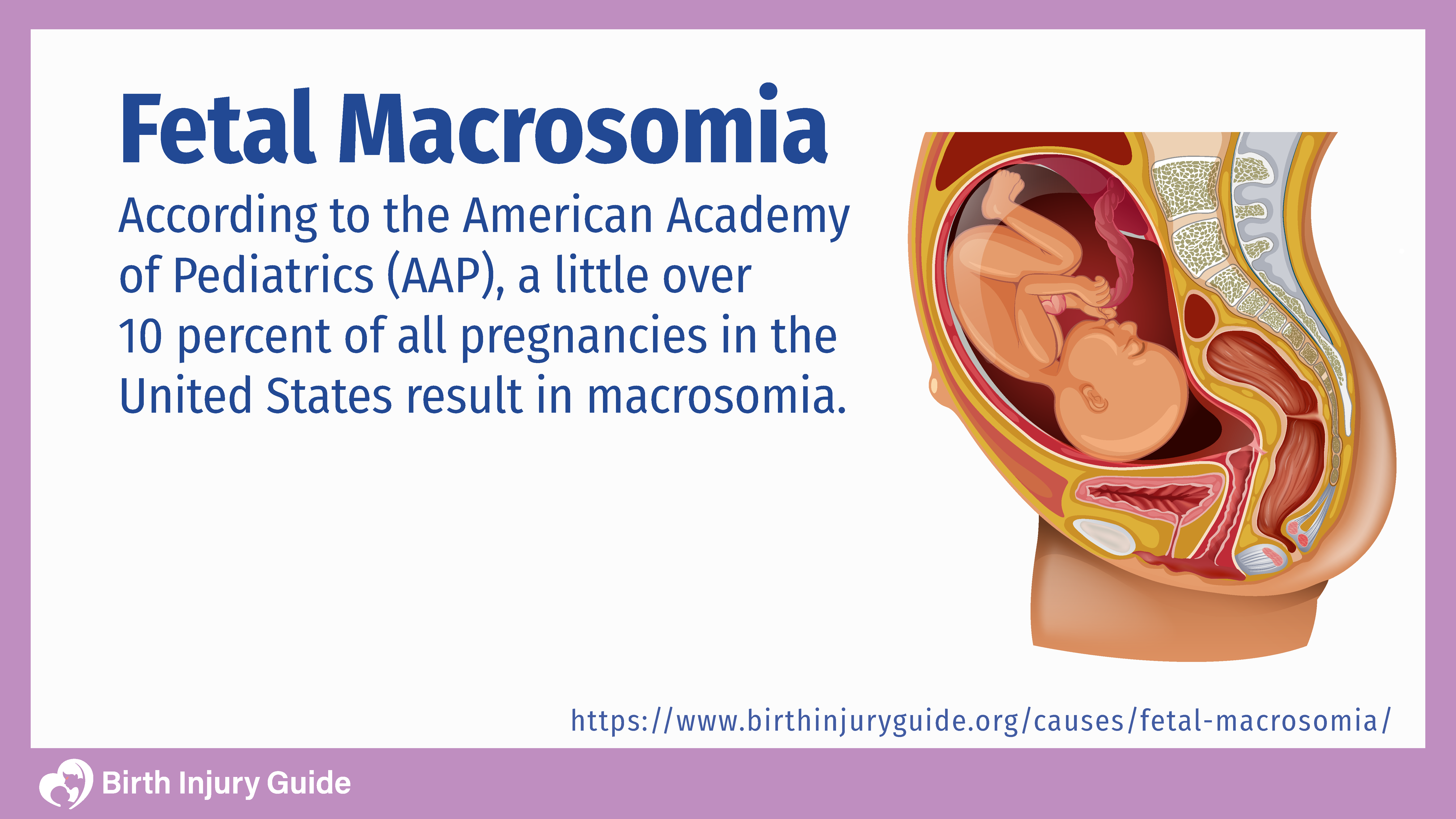
Fetal Macrosomia
During pregnancy, physicians must carefully monitor mom and baby to make sure that the pregnancy is developing normally. They must also diagnose and treat any issues that can result in potential birth injuries. One possible complication is fetal macrosomia, a condition in which babies are unusually large for their gestational age. The average birth weight for babies in the United States is seven pounds. With macrosomia, however, the baby will weigh significantly more.
Macrosomia occurs in around 10% of all pregnancies. It is more common in women who have gestational diabetes, or who have a history of pregnancies with macrosomia. Macrosomia creates a high-risk pregnancy situation because it is more difficult for a large baby to pass through the birth canal. This is especially true if the mother’s pelvis is small. Macrosomia can lead to a host of medical issues, including birth injuries and life-threatening medical complications.
What is Fetal Macrosomia?
When an infant’s estimated weight is higher than 90% of the average weight of babies in the same gestational age range, they are considered large for their gestational age. Yet that’s only part of how fetal macrosomia is defined. Macrosomia is also considered a high-risk pregnancy in which the mother and infant are at risk for medical problems. Macrosomia can make labor more difficult, or can even prevent a safe vaginal delivery. Sometimes the risks to the baby are so great that a c-section is necessary to prevent possible complications.
Most doctors consider macrosomia to be a birth weight of more than 9 pounds, 15 ounces (4,500 grams). Some doctors consider it to be a birth weight of more than 8 pounds, 13 ounces (4,000 grams). At these weights, normal delivery is difficult, and often ends in a cesarean section surgery (C-section) and/or early labor induction.
In the United States, around 7.8% of babies born had a birth weight of more than 4,500 grams. Only 0.1% had a birth weight of greater than 5,000 grams. The rates of fetal macrosomia are much higher among mother with gestational diabetes, with 22.3% of women with diabetes having a high birth weight baby, as opposed to only 13.6% of women without diabetes. Macrosomia is more common among Hispanic mothers, possibly because Hispanic women have higher rates of gestational diabetes. High birth weight is also more common in male babies, who are generally 150-200 grams larger than female babies.

Fetal Macrosomia Symptoms
Unfortunately, fetal macrosomia is often difficult to detect. There there a few tests that can be performed if there are signs of an unusually large baby. Doctors will check for signs, including:
- Excessive Amniotic Fluid: During a prenatal visit, a physician can measure amniotic fluid via an ultrasound. Excessive amounts of amniotic fluid may indicate that the infant is larger than expected. Larger babies tend to urinate more, which leads to a higher amount of amniotic fluid.
- Fundal Height: During a prenatal visit, physicians can also measure the distance of a pregnant woman’s pelvic bone to her uterus. Known as a fundal height measurement, this gives doctors a better understanding of how large the infant is.
- Ultrasound: Measurements of the estimated fetal weight by ultrasound is the primary method to diagnose macrosomia despite an error rate or variance of 15 percent.
What Causes Fetal Macrosomia?
Fetal macrosomia can occur when the pregnancy continues past the due date. This is one of the more significant risk factors because the baby continues to grow in the womb and can become larger than what the mother’s body is capable of handling safely. Other risk factors and potential causes of macrosomia include:
- Maternal obesity
- The mother gains significant weight during the pregnancy
- Maternal diabetes or gestational diabetes
- Previous history of large birth weight babies
- The mother is over 35 or under 17 years old
- The baby is a male
According to Carol L. Archie, M.D. of the University of California at Los Angeles School of Medicine, maternal diabetes and obesity can lead to macrosomia as an infant typically receives too many nutrients.
“Big parents often have big babies, but sometimes babies are unusually large because the mother is obese or has developed gestational diabetes during her pregnancy that was undiagnosed or untreated,” Dr. Archie says.
Untreated gestational diabetes is a very possible cause of large infants. When a mother has undiagnosed hyperglycemia (high blood sugar), the baby receives insulin and growth hormones in the womb. This stimulates fetal growth and deposition of glycogen and fat. This can also happen if the mother has glucose intolerance. Maternal glucose is passed through the placenta to the fetus, which can cause fetal hyperglycemia.
Other factors associated with fetal macrosomia include post-term pregnancies, mothers of Hispanic origin and a history of previous large babies. Males also have a higher rate of being born with macrosomia when compared to females.
In some cases, there is no known cause of fetal macrosomia. Still, it is best that expectant mothers take steps to reduce risk factors.
Fetal Macrosomia Complications
Both mother and infant are at risk for complications if fetal macrosomia occurs.
Complications for Mothers
For mothers, one of the major complications includes a difficult pregnancy, labor and delivery. These complications can lead to maternal injuries including:
Labor Problems
If a normal labor and delivery occurs, a large infant may become caught in the birth canal. This can result in doctors using birth-assisting tools to help delivery. Forceps and vacuum extraction can increase the risk of the baby suffering injuries.
Genital Tract Lacerations
A large baby can cause the birth canal, cervix and vaginal opening to be stretched excessively. This can cause injuries to those areas, including lacerations. These are tears to the muscles and vaginal tissues between the vagina and rectum (perineum).
Bleeding after Delivery
After delivery, the uterine muscles should contract and control bleeding. Fetal macrosomia increases the risk of improper contraction, however, which can cause bleeding after delivery. In some cases, bleeding is significant and can lead to hemorrhaging and anemia.
Uterine Rupture
A uterine rupture is a rare but serious complication that is more likely to happen if there is fetal macrosomia. Women who have had previous c-sections or uterine surgeries are the most likely to experience a uterine rupture. A uterine rupture occurs when, during labor, a scar line from a previous surgery tears open. This is a medical emergency and the baby must be immediately delivered via c-section to prevent life-threatening complications.
Complications for Infants
Infants are at greater risk for birth injuries. For instance, a difficult labor and delivery process puts a baby in danger of shoulder dystocia, nerve damage and oxygen deprivation at birth. Any of these can lead to permanent health issues and disorders. If oxygen and blood flow both are restricted, then then your baby may have what is called a hypoxic ischemic brain injury.
Shoulder Dystocia
Shoulder dystocia is one of the most common injuries caused by fetal macrosomia. Shoulder dystocia occurs when the baby’s shoulders become lodged behind the mother’s pelvis. When a baby is too large for the birth canal, it is a condition called cephalopelvic disproportion. In other words, the baby is disproportionately large for the mother’s pelvis. When shoulder dystocia occurs, doctors must act quickly. If continuing with a vaginal delivery is the safest option, doctors must be careful not to pull too hard and cause broken bones or a brachial plexus injury. Doctors must also carefully monitor the baby’s vital signs for signs of oxygen deprivation, which could lead to brain damage.
Nerve Damage
Nerve damage is another potential complication of fetal macrosomia. More specifically, nerve damage to the brachial plexus network of nerves is possible. A brachial plexus injury is an injury to one of the five nerves in brachial plexus – the nerves that run from the neck and shoulder, down the arm and into the hand. Any type of forceful pulling and stretch or tear these nerves, which can cause weakness, loss of sensation, loss of movement and even paralysis.
Hypoxic Ischemic Encephalopathy
Hypoxic ischemic encephalopathy (HIE) is a type of brain damage caused by lack of oxygen around the time of birth. When a baby is deprived of oxygen, they are at risk of brain damage, which can be severe or even life-threatening. Babies with HIE often have developmental delays, cognitive issues, neurodevelopmental delays, and even disorders like epilepsy or cerebral palsy.
Increased Risk of Health Problems
Infants who have macrosomia at birth may be more at risk for certain health problems later in life. Infants with a high birth weight may have childhood obesity. They are also at risk of developing metabolic syndrome. Metabolic syndrome is a condition marked by high blood sugar levels, increased blood pressure and excessive body fat around the waist. When these issues are combined, the child is also in danger of heart disease and stroke later in life.
Diagnosis and Treatment Options
It can be difficult to determine exactly how big a baby is during pregnancy, or how big they will be at the time of birth. Generally, a diagnosis of macrosomia is made retrospectively – or after the baby is born. However, during prenatal visits, doctors can use ultrasounds to learn as much as possible about the fetuses size and weight. During an ultrasound, the doctor will look at a variety of things to determine the baby’s size and diagnose suspected fetal macrosomia. These factors include:
- Maternal fundal height – this is the distance between the top of the uterus to the pubic bone.
- The amount of amniotic fluid – Abnormally high levels of amniotic fluid in the womb can be a sign that the baby is larger than average.
- Estimated fetal weight – Based on calculations taken during an ultrasound, the baby’s weight can be estimated.
Once a diagnosis is made, your doctor will make recommendations. If fetal macrosomia is caused by gestational diabetes, physicians will work closely to ensure the mother regulates her blood sugar. This can include following a healthy diet plan and a safe exercise regimen. It may include medications such as insulin if blood sugars are consistently high.
Although having a normal delivery is not necessarily impossible for mothers with large infants, a C-section, in many cases, is the best option. Although a C-section comes with its own set of risks, the benefits typically outweigh them. For example, a C-section will eliminate the possibility of birth injuries caused by birth-assisting tools as well as injuries such as shoulder dystocia or a fractured collarbone. Doctors will generally recommend a c-section if you have suspected fetal macrosomia and:
- You have diabetes
- The baby is estimated to be over 11 pounds
- You have a history of large infants or shoulder dystocia
After delivery, your doctor will assess the baby for any signs of a birth injury. Depending on the baby’s health, gestational age, birth weight etc. they may need to spend some time in the neonatal intensive care unit (NICU). Your healthcare team will carefully monitor the baby for signs of complications or injuries, including oxygen deprivation or nerve damage.
Prevention
Fetal macrosomia is an unpredictable condition. Sometimes, a diagnosis can only be made at the time of delivery. There are cases where fetal macrosomia occurs for no apparent reason. However, pregnant women can help reduce maternal risk factors by:
- Plan Your Pregnancy: Women who are trying to conceive can reduce the risk of complications like fetal macrosomia by talking to their healthcare provider before conception or early on in the pregnancy. Women who are overweight or obese may be referred to specialists that can help them get or keep their weight under control before or during pregnancy.
- Watching Weight Gain: Although this may be difficult during pregnancy, gaining between 25 to 35 pounds only, the ideal weight gain during pregnancy, is recommended by most doctors. It’s important to note, however, that this is just a general guideline. It doesn’t always apply to everyone. A physician should work closely with you in order to find the ideal weight gain for your pregnancy and work to prevent excessive weight gain.
- Control Diabetes: Controlling blood sugar during pregnancy is one of the best ways to help prevent fetal macrosomia. Make sure your doctor does a gestational diabetes test during pregnancy.
- Keep All Prenatal Appointments: Prenatal check-ups are crucial during pregnancy as it allows doctors to examine the pregnancy and run tests to ensure everything is normal. Prenatal appointments measure fetal growth and overall fetal health. It also helps them prepare for your upcoming birth and the steps needed should you show signs of carrying a large infant.
- Stay Active: As much as you are able to healthily, stay active during your pregnancy. Unless you are restricted to bed rest, a healthy level of activity can help manage weight gain and prepare your body for labor and delivery. Your doctor can advise you on what is a healthy level of activity based on your overall health.
Prognosis for Infants
Babies that have a high birth weight will not necessarily experience any complications or birth injuries. In these instances, the prognosis is good. The baby will likely be monitored for possible health issues like childhood obesity or metabolic syndrome. This does not mean that your child will experience these conditions, but they may be at an increased risk.
If the baby does experience a birth injury, then the prognosis may change depending on the injury and severity. For example, a brachial plexus injury may require additional medical care and may lead to permanent dysfunction in the affected arm. Often, babies with nerve damage or broken bones do recover without additional complications or long-term health issues.
Similarly, if the baby suffers HIE or brain damage, they may develop disorders like cerebral palsy. Cerebral palsy is a lifelong disorder for which there is no cure. Instead, treatment consists of managing symptoms and helping the child become as healthy and independent as possible. Disorders like cerebral palsy have a profound impact on the prognosis and the future for the family affected. Talk to your doctor about the risk factors for conditions like cerebral palsy.



